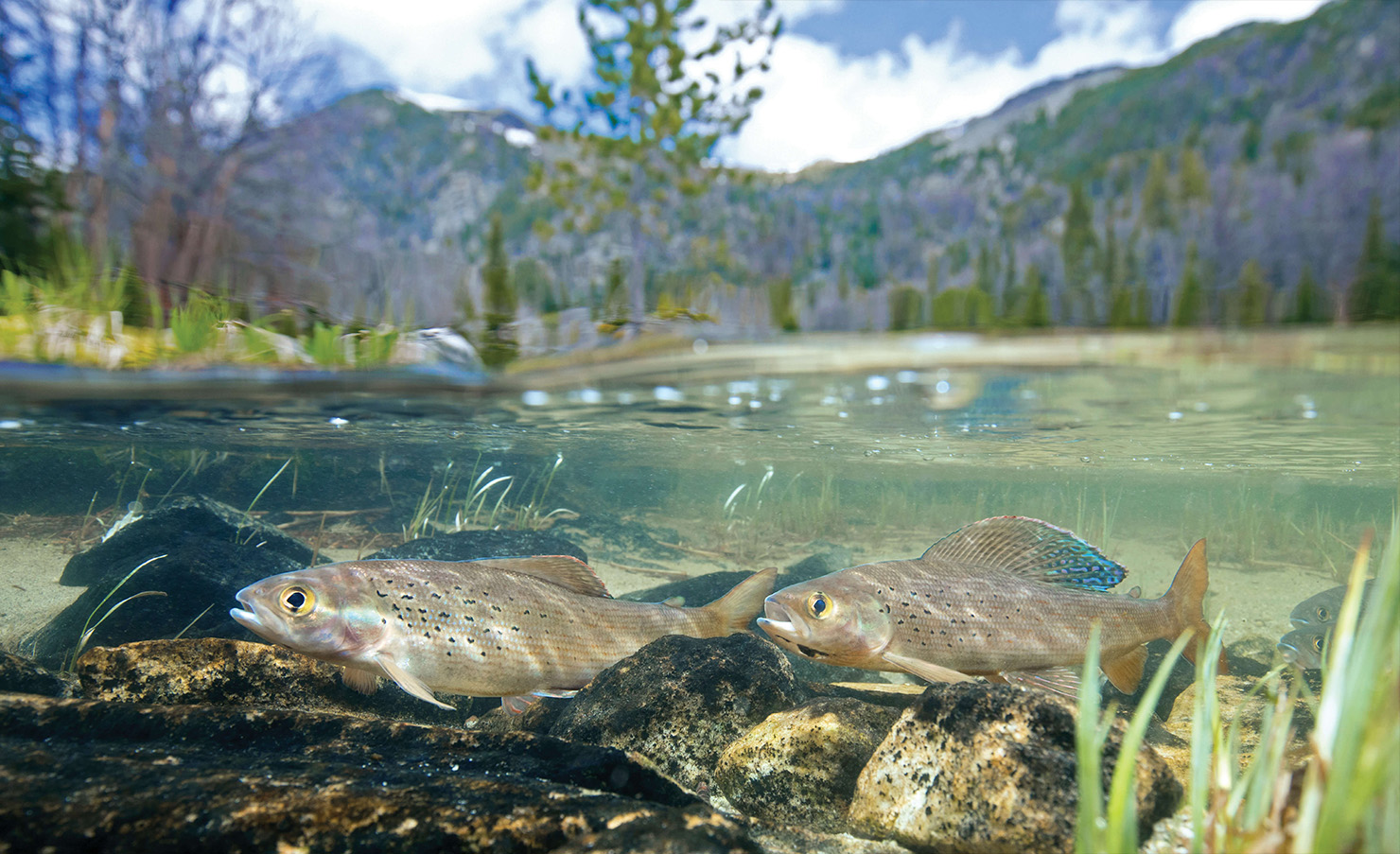
02 Feb Where Grayling Thrive
With a nearly imperceptible disturbance of the water’s surface, the fly disappeared. I quickly and firmly — but without too much force — lifted my rod upward with one hand, while pulling in some line with the other. The line went taut and I could feel the fish tugging at the other end as my rod bent toward the water. After missing on several strikes, I had hooked one. I stripped line in and before long I could see silvery flashes underwater as sunlight reflected off the struggling fish. Moments later, I wetted my hands, netted the fish, and handled it just long enough to remove the fly before returning it to the net so I could admire it in the safety of the water on that warm, clear August morning. There is, after all, something special about catching an arctic grayling, particularly in the angler’s paradise that is Montana.
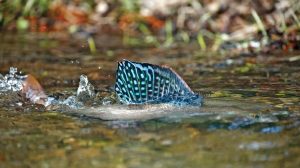
Adorned with a brilliantly-colored dorsal fin, grayling have long been a favorite of anglers. Photographed by Fish Eye Guy Photography
Several traits have long endeared grayling to anglers. Their large, colorful dorsal fins make them one of North America’s most beautiful fish. Those sail-like fins, moreover, help the fish — which rarely surpass a foot and a half long in Montana — put up a more vigorous fight when hooked than one might expect. And that can happen often, as grayling have a reputation for vigorously chasing flies.
But perhaps the biggest thrill of landing a grayling comes from knowing that the species is rare in the contiguous United States. In the 19th century, Anglo-Americans found them only in parts of the upper Missouri River system above the Great Falls, and in the northern half of Michigan’s Lower Peninsula. They were relicts of the last ice age, the Pleistocene epoch, pushed southward by the ice sheets and left behind when the glaciers retreated. But Anglo-American activities — such as fishing, logging, mining, building dams, and developing irrigation systems, as well as introducing non-native eastern brook, rainbow, and brown trout — soon eroded grayling populations. Efforts to save the Michigan grayling — which included importing Montana grayling eggs — proved futile; the fish vanished from the Wolverine State by the mid-1930s. Historically, the species mainly inhabited streams in the Treasure State, but fluvial (stream-dwelling) grayling survived in approximately 5 percent of their range by the 1980s. In 1991, conservationists initiated an ongoing legal battle when they petitioned the U.S. Fish and Wildlife Service (USFWS) to protect Montana’s remaining fluvial grayling under the Endangered Species Act; most recently, in 2020, the agency determined that a listing was not warranted.
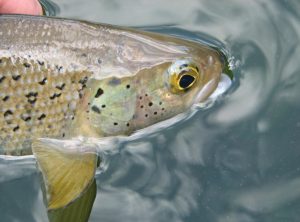
Although habitat alterations exacted a heavy toll on Montana’s grayling populations, the species is also notoriously vulnerable to over-fishing. Photographed by Jeremie Hollman
Fortunately for anglers, grayling now thrive in some of the lakes to which they were introduced. In fact, the USFWS cited the existence of healthy populations in lakes scattered throughout the upper Missouri drainage as part of its reason for not listing the grayling. But 14 of the 19 total populations that the agency considered in its 2020 determination were lake-dwelling (lacustrine) populations created through hatchery work. During the 20th century, the Montana Fish and Game Department (now Montana Fish, Wildlife & Parks) and the U.S. Bureau of Fisheries (now USFWS) stocked over 100 million eggs and fry derived from lacustrine grayling into waters across the Treasure State. Although many lake plantings failed, the agencies ultimately established over 30 lacustrine populations in Montana. Meanwhile, every attempt to introduce the species to streams beyond its historic range, bolster native fluvial populations, and re-establish the fish in streams from which it had been extirpated bore no fruit before the new millennium. Only recently did the state successfully reintroduce fluvial grayling to a former haunt: the upper Ruby River.
It was from one of the lakes in which Montana Fish and Game established the species long ago that I pulled that grayling and several others on that gorgeous August day. Lake Agnes lies in southwestern Montana’s Pioneer Mountains, tucked in the Beaverhead-Deerlodge National Forest, at 7,537 feet above sea level. The lake is remote, but accessible; carrying bear spray is advisable during the short, strenuous hike. From the Glen exit on Interstate 15, about 20 miles north of Dillon, take Rock Creek Road — which is mostly a rocky trail — 7 miles to the trailhead at Brownes Lake. Along the way, visitors get a glimpse of Montana’s ecological diversity, as the irrigated valley bottom of the Big Hole gives way to arid, sagebrush-covered foothills, which transition to a dense forest of moss-covered conifers blanketing the mountains. The trail to Agnes measures only about a mile and a half long, but boasts nearly 1,000 feet in elevation gain.
A picturesque view of Lake Agnes awaits hikers at the trail’s end. A sizeable waterbody that encompasses 108 acres and reaches 59 feet deep, Agnes sits at the head of Rock Creek, a tributary to the Big Hole. Pine-covered mountainsides surround the lake, sloping to its shores. Although Agnes is a natural waterbody, a headgate installed at its outlet regulates the seasonal withdrawal of water for irrigation. That structure is the only blemish along a shoreline that varies between sandy beaches and piles of boulders, with occasional deadfall adding further variety. Each summer, Agnes experiences some drawdown for the benefit of irrigators downstream. The fish that swim in the lake represent the only other significant human impact on it.
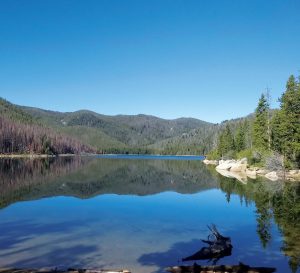
Visitors are treated to a spectacular view of Lake Agnes where the trail reaches the water. Photographed by Fish Eye Guy Photography
There was a time when no fish inhabited Lake Agnes, but its naturally fishless state drew the attention of fishery managers with Montana Fish and Game as they sought to create fishing opportunities and establish potential sources of eggs in “barren” high-mountain lakes. Surviving records indicate that Agnes first received grayling in 1928, when Anaconda hatchery employees hauled some 200,000 fry up to it. Georgetown Lake, a reservoir located west of the Continental Divide that received its first grayling in 1909, provided the eggs from which those fish hatched. By the 1920s, the Georgetown population was based on progeny of lacustrine grayling in the Madison and Centennial valleys. The agency stocked nearly 1.2 million more grayling in Agnes between 1933 and 1960; the final plants came from the state’s Somers hatchery near Kalispell and the federal facility outside of Ennis. No other fish species were ever stocked there.
Eventually, Lake Agnes contributed to Montana’s hatchery program. During the late 1930s, Georgetown Lake’s grayling population — Montana Fish and Game’s primary source of grayling eggs — crashed because of overfishing and a winterkill. While the agency restored that population, Agnes sustained hatchery production. In 1940, department personnel used a temporary trap to take over 300,000 eggs from grayling spawning in its primary inlet. The next year, they installed a permanent trap and erected a cabin to provide shelter from the heavy spring rains and the wood ticks that reportedly infested the area. The 1941 and 1942 harvests each surpassed four million eggs. Agnes remained a source of eggs after collections resumed at Georgetown, yielding over 10 million more eggs between 1943 and the final harvest in 1960.
Then, the grayling of Lake Agnes became a potential problem as fisheries management evolved during the following decades. When the state looked to preserve and restore the Big Hole’s fluvial grayling population during the 1990s, it identified the fish inhabiting Agnes as a potential genetic threat because of their lacustrine heritage and origins beyond the Big Hole basin. After all, Rock Creek — although a small stream regulated by a headgate at the lake’s outlet — connects Agnes to the Big Hole. The agency ultimately concluded that fish were unlikely to access the river from the lake, and so they remain in Agnes today, awaiting anglers who make the challenging hike to reach them.
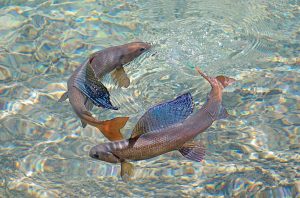
Each spring, grayling spawn in Lake Agnes and other high-mountain lakes and their tributaries. The Montana Fish and Game Department (now Montana Fish, Wildlife & Parks) collected a total of approximately 20 million grayling eggs from spawning fish at Agnes between 1940 and 1960. Photographed by Fish Eye Guy Photography
But the fishing makes the journey worthwhile. A study completed during the early 1970s estimated that there were some 24,000 adult grayling in Lake Agnes. My informal sampling conducted by hook andw line — the way that biologists originally surveyed Montana’s fisheries — suggests that the lake holds plenty of grayling today.
I first visited Agnes in July 2019, after a weekend spent touring various past and present grayling waters in southwestern Montana. I was planning to write about grayling, but had never caught one and so I hoped to change that lest I feel like a fraud as an author and angler. No grayling humored me that weekend, so I decided to stop by Agnes on Monday morning in a final attempt to land one as I returned from Dillon to Helena, where I was doing research at the Montana Historical Society.
Thankfully, Lake Agnes obliged. The beauty of the lake and the solitude I found there — I saw not another soul from the time I exited I-15 until I returned to it a few hours later — made for the perfect setting as I discovered that the experience of catching a grayling lived up to the accounts that I had read in late 19th-century sporting journals. In less than an hour, I landed three grayling measuring between 8 and 14 inches long. Sight fishing from a boulder near the trail, I could see several grayling swimming around a submerged log, perhaps 10 yards away. After they refused to bite a dry fly (one had risen to inspect it, but apparently did not like what it saw), I deployed a dry-dropper rig, with the nymph — a rainbow warrior — to catch all three fish. The first and largest fish that I landed put up a stronger fight than I anticipated and took a few moments to recover a few feet from shore upon release; I appreciated the opportunity to gaze at a fish that, just minutes before, had been more of an abstraction — something I had merely read about and seen photos of — than a reality to me. I missed on another handful of strikes before departing in regret that I had merely tacked the brief visit onto the end of my weekend trip. But I knew that I would be back.
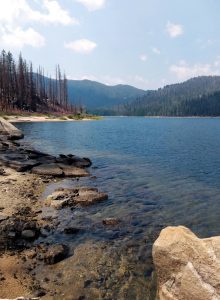
Remote and pristinely wild, Lake Agnes covers 108 acres and reaches 59 feet deep. Photographed by Adam R. Hodge
The lake was visibly lower when I returned in August 2021, and I saw no grayling patrolling near the shore; they had apparently retreated to deeper, cooler waters. This time, the bottom half of my dry-dropper rig, which initially featured the same rainbow warrior that I had used two years earlier, elicited little interest. Instead, the fish solely hit the dry fly — a purple micro chubby Chernobyl that I had mainly chosen because I thought it would serve as a fine indicator — and I eventually ditched the dropper. Encircling the entire lake over the course of about five hours, I landed seven grayling measuring 12 to 15 inches long, while missing on at least a dozen strikes. I saw no one else until I nearly completed my circuit and encountered a few other anglers wetting their lines near the trail. Having caught my share and accepting that I no longer had the solitude that I treasure, I knew it was time to head back down the trail. When I met a small group of fishermen heading toward the lake, I could only smile and nod when they asked if the fish were biting. That is, after all, their very purpose up there now.
Relicts of a bygone age in which fisheries management meant creating, maintaining, and improving recreational fisheries, the grayling of Lake Agnes offer anglers a rare opportunity to catch a species once abundant in the upper Missouri drainage. It can take some work to reach such waters as Lake Agnes, but one might argue that it makes landing a piece of Montana’s natural heritage even more fulfilling. So while the ongoing battle over Montana’s precious few fluvial grayling commands much more public attention, anglers would do well to know about — and visit — Agnes and other mountain lakes where grayling thrive.




No Comments